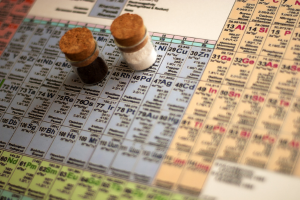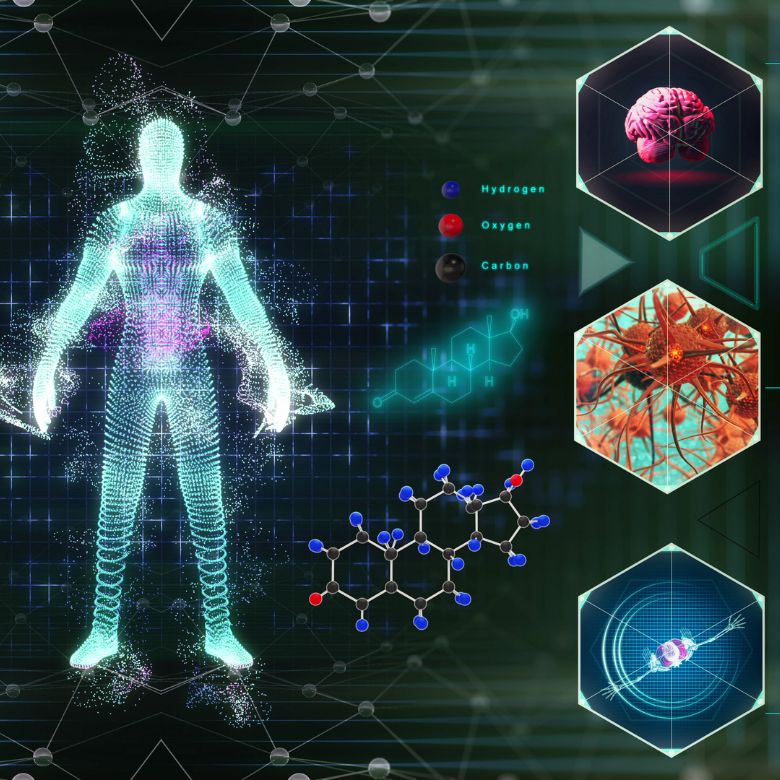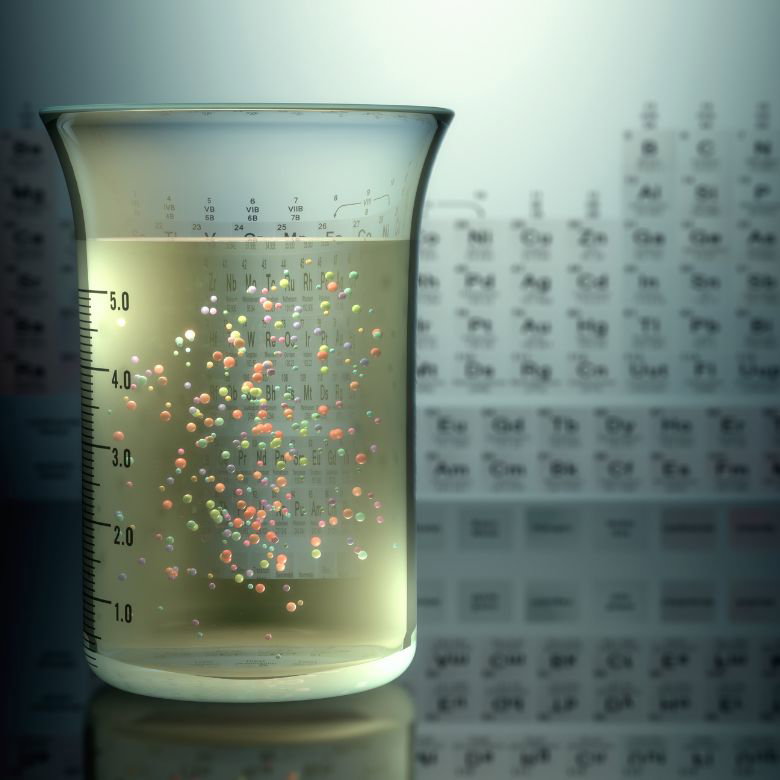There are dozens of chemical elements in the Universe, on Earth and in all living organisms. They are also present in human bodies and have many functions there. Their presence and concentration affects how healthy we are, what our complexion looks like and our current mood. So it is worth getting to know them better and looking at their characteristics.

Biogenic elements in the human body
It is clear that it is not only the supplied quantity, but also the quality of the bio-elements that is important. It is worth knowing that they are part of, among other things, bone tissue, body fluids, certain enzymes and high-energy compounds, and regulate organ and systemic functions.
The most qualitatively beneficial elements for humans are those that the body obtains directly naturally and those consumed in the form of low-processed foods. They are usually in the form of liquids, infusions of medicinal herbs, raw vegetables and fruits or seeds. In these forms, bio-elements are most easily absorbed and at the same time virtually impossible to overdose on.
Compared to natural sources, taking these elements in the form of synthetic drugs or supplements results in much lower bioavailability and often tolerance problems. In addition, their inappropriate use can lead to an overdose and consequent deterioration of health. This is because not only a deficiency of bio-elements, but also an excess of bio-elements has serious consequences and changes in physiological functions. Each of these situations – excess and deficiency of biogenic elements – leads to body dysfunction, i.e. disease.
Biogens
All the elements necessary for the proper development and functioning of living organisms are called biogens. The key ones are those that are part of proteins, nucleic acids and the many organic compounds that make up all organisms. These include carbon, hydrogen, nitrogen and oxygen. However, there are many more important bio-elements, for example:
- Phosphorus, which in its oxidised form forms the compounds found in nucleic acids and also forms the energy system of the cell.
- Sulphur, which is one of the building blocks of two important amino acids for organisms – cystine and methionine. In addition, interactions between the -SH groups of these amino acids in the form of disulfide bridges allow the tertiary structure of the proteins to be maintained.
Based on the quantity in which they occur in living organisms, bioelements can be divided into three groups – microelements, macroelements and ultratrace elements.
Macroelements
These are bio-elements that are essential for the proper functioning of organisms and are found in relatively large quantities. This term generally refers to elements whose daily human dietary requirement is more than 100 mg per day for normal development. It is estimated that they account for no less than 0.1% of human mass, and their percentage distribution should be approximately: 65.04% oxygen (O), 18.25% carbon (C), 10.05% hydrogen (H), 2.65% nitrogen (N), 1.4% calcium (Ca), 0.81% phosphorus (P), 0.27% potassium (K), 0.26% sodium (Na), 0.25% chlorine (Cl) and 0.21% sulphur (S). This group of chemical components in plants accounts for more than 0.1% of dry matter.
If they are deficient, vital functions are disrupted and plants die. In human bodies, these are elements that are part of key organic compounds such as proteins, lipids and carbohydrates. Macroelements are released in the digestive tract after ingestion, then enter the bloodstream in the form of ions, from where they are transported to all cells and tissues.
Their bioavailability is affected by various factors, for example the presence of vitamins or the pH of the environment. Conversely, compounds such as oxalic acid, phytates or excessive amounts of dietary fibre and fats are unfavourable for the absorption of macroelements.

Occurrence, role and effects of abnormal amounts of selected macroelements in the human body
- Nitrogen is part of the amino group of the amino acids that make up proteins, is present in the rings of purines and pyrimidines that make up nucleic acids, and is also a component of numerous pigments, auxins, alkaloids and vitamins. In human bodies, nitrogen deficiency impairs metabolism and general vital functions.
- Calcium is an essential building block for bones, an activator of enzymes, a factor responsible for blood clotting and a regulator of cell excitability in nerve and muscle tissues. When deficiencies of this element occur, symptoms of abnormal development and function of the skeletal system – such as increased bone fragility or osteoporosis – are very common. In addition, people with reduced calcium have been observed to develop tooth decay, periodontitis, blood clotting disorders and even a pathophysiological condition called tetany, which is characterised by excessive muscle contractions. Rapid loss of calcium is influenced by excess salt, high caffeine consumption and alcohol, among other factors. An excess of this bioelement can lead to the formation of kidney stones.
- Potassium is an ingredient responsible for many functions in the body. It is a regulator of the osmotic pressure of the cell and a regulator of the intensity of transpiration. It is responsible for maintaining the membrane potential and excitable state of the cell. It is involved in the activation of enzymes and plays an important role in the nyctinastic and seismonastic movements of whole organs. In the case of potassium deficiency, abnormal function is observed of smooth and skeletal muscles, as well as decreased contractility of the heart muscle, arrhythmia and body acidification. In contrast, an excess of more than 18 g causes cardiac arrest.
- Sodium is a component that influences the action potential of excitable cells and the osmotic pressure of extracellular fluid. It has an alkalising effect, improves and regulates nutrient transport activity, and maintains muscle and nerve function. There are very rare cases of sodium deficiency. Bringing the body to such a state results in rapid dehydration due to increased urine excretion. There is then a reduction in blood pressure and a disruption in the formation of the action potential of excitable cells. Whereas excess sodium results in hypertension, kidney disease and even stroke.
- Chlorine is the primary anion found in the body. It takes an active part in digestive processes, as the hydrochloric acid (HCl) present in the stomach is an essential ingredient in maintaining the right environment to promote the work of enzymes, such as pepsin. It is also an activator of other enzymes, including salivary amylase. Its deficiency leads to a disruption of water-electrolyte balance, digestion-related processes and respiration. It may be the component responsible for disrupting growth and weight loss processes. Excess may manifest itself as disorders on the part of the neuromuscular system.
Microlements
In contrast to macroelements, microelements are compounds present in plant and animal organisms in trace amounts. They usually account for a maximum of 0.01% of plant dry matter. However, just like macroelements, they are essential for the body to function properly. Their distribution in the body is approximately 0.02% iron (Fe), 0.04% magnesium (Mg) with even smaller amounts of manganese (Mn), copper (Cu), zinc (Zn), iodine (I), fluorine (F), chromium (Cr), manganese (Mn), molybdenum (Mo) and selenium (Se).
In humans, the demand for microelements is no more than 100 mg per day. They are components of enzymes, body fluids and tissue builders, particularly bone tissue.

Occurrence, role and effects of abnormal amounts of selected microelements in the human body
- Fluoride is primarily a component of fluorohydroxyapatite, the mineral building block of teeth and bones. Its deficiency mainly leads to dental diseases – the occurrence of decay and cavities and high temperature sensitivity. It also adversely affects the balance of macroelements – phosphorus and calcium. It can also be a cause of weakened bones and the occurrence of related diseases, such as osteoporosis. In excess amounts, fluoride is toxic.
- Iron is a component of haemoproteins, cytochromes and many other enzymes. As a component of haemoglobin, it is involved in oxygen transport processes in the body. In addition, it is responsible for binding carbon dioxide in it and expelling it from the body. The consequences of a deficiency can include disruption of respiratory processes, anaemia, general weakness of the body, headaches and cardiac arrhythmia. In extreme cases, it leads to mental and physical developmental delay.
- Iodine is a bio-element found mainly in the hormones thyroxine and triiodothyronine. It is responsible for the normal functioning of the thyroid gland and its deficiency leads to a characteristic symptom – an enlarged goiter, which results in insufficient production of TSH. This is accompanied by a slowed metabolism and rapid weight gain, constant weakness, lethargy, feeling cold, compromised immunity and constipation. Whereas excess iodine in the body leads to hyperthyroidism, increased bronchial mucus and skin lesions. In extreme cases, there are symptoms such as burning in the mouth, throat and stomach, as well as gastrointestinal disorders, proteinuria and serious heart complaints. Women with iodine deficiency may experience disorders of monthly menstrual cycles and reproduction. Adequate iodine intensifies the sex drive and promotes the production of gametes.
- Zinc is a component of the active centre of enzymes such as RNA polymerase and enzymes regulating protein and carbohydrate metabolism. It is responsible for the normal metabolism of proteins, carbohydrates, fats and alcohols. It provides a kind of antioxidant barrier to protect the body from free radicals. It contributes to the maintenance of healthy hair, nails and skin and protects the skin against bacterial acne. Its deficiency interferes with the functioning of the gonads and compromises wound healing. It sometimes causes pregnancy disorders and poor foetal development. In children, it can lead to developmental delays and underdevelopment of the genitalia. Excess is deposited in the liver and can contribute to reducing the HDL fraction of cholesterol. In addition, nausea and constipation may occur, and acute symptoms include severe stomach pain and reduced appetite.